This site uses only a few technical cookies necessary for its operation. By continuing to browse, you accept their use.
To find out more...
To find out more...
Beans in primeur
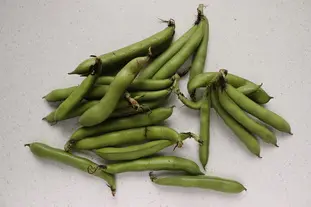
As I write this, it is the beginning of the short season for fresh beans. If you've never made them before and you're just starting out (and that's a great idea) you'll find that it's a bit time consuming to prepare, you have to shell them once, remove the beans, scald them to remove the skin (and the germ for the purists) and then only use them in a recipe.
It's hard work, but it's delicious...
This being said, there is a little known aspect about beans, they are the so-called "primeur" or "en primeur" beans, which are prepared in a very different and much faster way.
It's hard work, but it's delicious...
This being said, there is a little known aspect about beans, they are the so-called "primeur" or "en primeur" beans, which are prepared in a very different and much faster way.
14 K
Keywords for this post:BeansEarly vegetablesGreen vegetablesPodsLast modified on: June 4th 2022
Beans in primeur
In early season?
This is said of beans at the very beginning of the season, when they are still small, 8-10 cm maximum, and very tender.If you find some of this size, you often have to ask the farmer, it's quite surprising but you should know that everything is eaten in the beans at this time, the beans of course (not very big at this age), but also the pod that contains them.
How to do it ?
The trick is to work them a bit like green beans: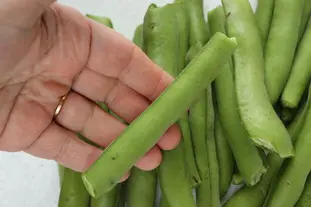
1) We break the 2 ends of the terminal by pulling to remove any wires, but there are very few in general.
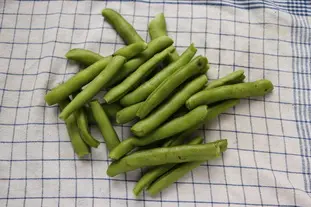
2) We wash and dry them.
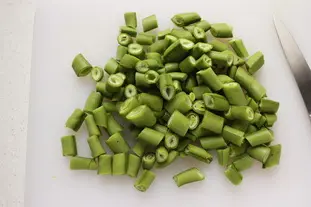
3) We cut them in small pieces, to your taste.
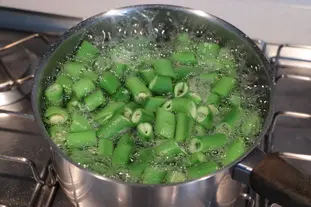
4) We cook these small pieces as you are used to with other green vegetables, I like to cook them first in English (boiling salted water 3-4 minutes) and then cooled and drained, returned with a knob of butter or a little olive oil.
You will be surprised by the taste, something between snap beans and peas it seems, and the texture, very soft.
Don't hesitate to mix these beans with other vegetables for a varied and colorful dish.
To sum up: You can enjoy early beans, at the beginning of the season, by treating them a bit like green beans, which allows you to eat the whole pod, it is both delicious and very economical.
Lasts posts
Butter vs. grease
We often read in a recipe where a pastry is put into a mould that, just before pouring, the mould should be buttered or greased. But what's the difference between these 2 terms?December 1st 20251,0425
Getting out of the fridge early
Very often when you're cooking, you need to take food or preparations out of the fridge, to use them in the recipe in progress. There's nothing tricky about this: you just take them out of the fridge and use them, usually immediately, in the recipe. But is this really a good method?November 24th 20251,1475
Who's making the croissants?
When you look at a bakery from the outside, you naturally think that in the bakery, the bakers make the bread, and in the laboratory, the pastry chefs make the cakes. It's very often like that, with each of these professions having quite different ways of working, but sometimes there's also one...November 23th 20251,038
Oven height
When we put a dish or cake in the oven, we naturally tend to put it on the middle shelf, and that's what we usually do. But in some cases, this position and height can be a little tricky, so let's find out why.October 8th 20252,8165
The importance of sieving
In recipes that use a fine powder (flour, powdered sugar, etc.), you'll often see the advice to sift before using it. To sift is to pass the powder in question through a sieve (a very fine strainer) before incorporating it into your recipe. It's often advice, but is it really useful?September 3rd 20257,5683
Other pages you may also like
Tranché, dissociated, failed, in short... missed!
When preparing a sauce or a cream, there's always a (small) risk that the creamy preparation you're working on will suddenly separate into two parts of different textures: a liquid part, for example, and a more or less solid part, or even become lumpy. It's terribly frustrating, but we'll see...June 19th 202313 K5
Remove bones from fish
Let's talk about fish: It's not a scoop, it's much more pleasant to eat fish from which all the bones have been carefully removed, even if it's a rather painful and time-consuming job, the result is worthy of your efforts. Here are some important points to keep in mind.October 16th 202114 K5
The return of the "Norman hole"
You maybe know the "trou normand", this old gastronomic custom typically French which consists in taking a (small) glass of calvados, generally between the last course and the dessert? It's something that seems a bit anachronistic nowadays, having a glass of an alcohol of more than 60° in the...December 18th 202115 K4.8
In Praise of the Vegetable Mill
When a recipe or preparation calls for something solid to be pureed, as in a soup for example, the natural reflex is to take out the blender and plunge it into the saucepan. This works very well in most cases, but there are times when you'd like to puree something and at the same time remove the...July 12th 202311 K5
Candied fruits: don't get ripped off
Do you like candied fruit? You might like to nibble a handful or add it to a recipe, like a classic fruit cake or delicious Italian specialities like panettone or sicilian epiphany pie.June 21th 201767 K 24.2
Post a comment or question
Follow this page
If you are interested in this page, you can "follow" it, by entering your email address here. You will then receive a notification immediately each time the page is modified or a new comment is added. Please note that you will need to confirm this following.
Note: We'll never share your e-mail address with anyone else.
Alternatively: you can subscribe to the mailing list of cooling-ez.com , you will receive a e-mail for each new recipe published on the site.









